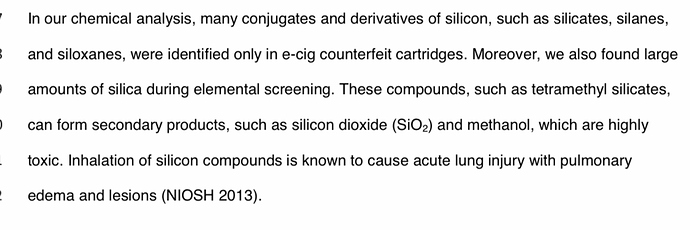This paper is just a pre print so I have not seen any discussion on it yet but a brand new study from the University of Rochester presents some interesting new findings:
I am curious what the extraction community thinks of this new research as I personally can’t really fathom where/how a number of these compounds would be getting into the oil. Perhaps some of you may have some ideas. Residual solvents and pesticides are explainable but where are things like silicon conjugated compounds and vitamin A (not E) making their way in?
1 Like
Considering it shows up mainly in the counterfit cartridges, i expect the silicon comes from use of poorly manufactured silicone seal material. Terpenes then leech these degradation products out into the oil.
3 Likes
silicone compounds… are morons using insulin syringes to fill carts?
2 Likes
Vitamin A seems like it could be a native molecule to hemp and cannabis. Perhaps the seals in carts are the source of the silicon compounds. Super ouch @ whatever medical cart failed for acetyl chloride tho the fuck is that.
2 Likes
possible some vacuum grease got in their distillate
6 Likes
Potentially the carrier oils used in the food grade terpenes. MSDS sheet usually don’t list them as they are considered proprietary. Most the pens & injectors contain silicone seals which degrade from Terpenes. I’ve also seen Vitamin A used to try to stop CBD from forming crystals
Oh you know what that’s actually a better explanation. These sorts of compounds are very characteristic of the breakdown products of injecting silicon polymers in a GCMS
1 Like
Perhaps silica is being eluted?
Vitamin E is thought to occur naturally in the flower. I assume it’s possible vitamin a could also. Silicon could be from the o-rings or insulation on wiring within the device, also if its a passive model where users breath activates the atomizer then the air they’re inhaling has traveled through the internals of the battery which could hold al sorts of manufacturing goodies, not sure if this could be quantified in their tests though.
There are inhalation studies on Vitamin A esters that suggested it may be useful in the treatment of certain lung cancers but this is not a topic I have researched much at all myself. I honestly have just never even heard of Vitamin A being used in oils but as mentioned above this does not appear to be the first time someone has tried it. It’s possible it can occur naturally in the plant but this was only reported in some dispensary cartridges so I think it is more likely that they are adding it to adjust viscosity.
